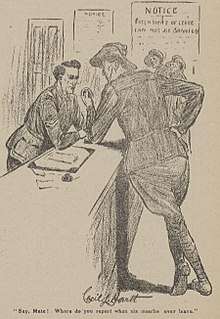Cecil Hartt
Cecil Lawrence Hartt (August 1884 – 17/19 May 1930)[1] was an Australian cartoonist, born in Prahran, Victoria.

He joined the 18th Battalion of the First AIF early in 1915, shortly after the outbreak of World War I and was wounded at Hill 60. He had been contributing cartoons and sketches to The Bulletin before enlisting, and continued after 1916 when was invalided to London. As much as anyone, he was responsible for the portrayal of the Australian "digger" as independent, easygoing and disrespectful of authority.[2] During his convalescence, he contributed to The London Bystander, Passing Show and London Opinion,[3] then worked as a staff sergeant leading a camouflage team.[4]
He was a good friend of the poet Henry Lawson.[5]
He was Smith's Weekly's first cartoonist, joining in 1919 and perfected his image of the "digger" in hundreds of joke drawings,[6] particularly in its Unofficial History of the AIF pages. After his death, this work was continued by Frank Dunne.
He was the first president of the Society of Australian Black-and-White Artists from 1924 and reelected in 1925.[5][7] (Soon changed its name to "Black-and-White Artists Society", then "Black-and-White Artists Club" and is now the "Australian Cartoonists Association".)
He was married to Ruby Adelaide Manners from 1909 to 1923 when they divorced.[8]
He killed himself on a remote road near Moruya, New South Wales with a shotgun to the head after complaining of "feeling rundown" and "needing a holiday". He left a widow Iris (later Smart) and three-year-old daughter Diana and a son Lawrence Chambers Hartt (1910–1942).[9][10] Lawrence was killed in action in Port Moresby during World War Two.
Publications
- Humorosities (Sydney 1917)[11] sold 60,000 copies
- Diggerettes (A. C. Sandford, Sydney 1919)[12]
- More Diggerettes (A. C. Sandford, Sydney 1920)[13]
References
- The Argus 17 May 1933
- Lindesay, Vane The Inked-In Image Heinemann, Melbourne 1970 ISBN 0-09-135460-9
- McCullough, Alan Encyclopedia of Australian Art Hutchinson of London 1968 ISBN 0-09-081420-7
- The Argus 16 July 1918
- http://www.cartoonists.org.au/?page=214
- Blaikie, George Remember Smith's Weekly Angus & Robertson, London 1967
- Sydney Morning Herald 9 September 1925
- Sydney Morning Herald 3 March 1923
- Sydney Morning Herald 22 May 1930
- Kokoda casualties
- "WAR BOOKS". The Sydney Morning Herald (24, 662). New South Wales, Australia. 20 January 1917. p. 8. Retrieved 18 May 2017 – via National Library of Australia.
- "MISCELLANEOUS". The Sydney Morning Herald (25, 548). New South Wales, Australia. 22 November 1919. p. 8. Retrieved 18 May 2017 – via National Library of Australia.
- "Classified Advertising". The Argus (Melbourne) (23, 033). Victoria, Australia. 29 May 1920. p. 6. Retrieved 18 May 2017 – via National Library of Australia.